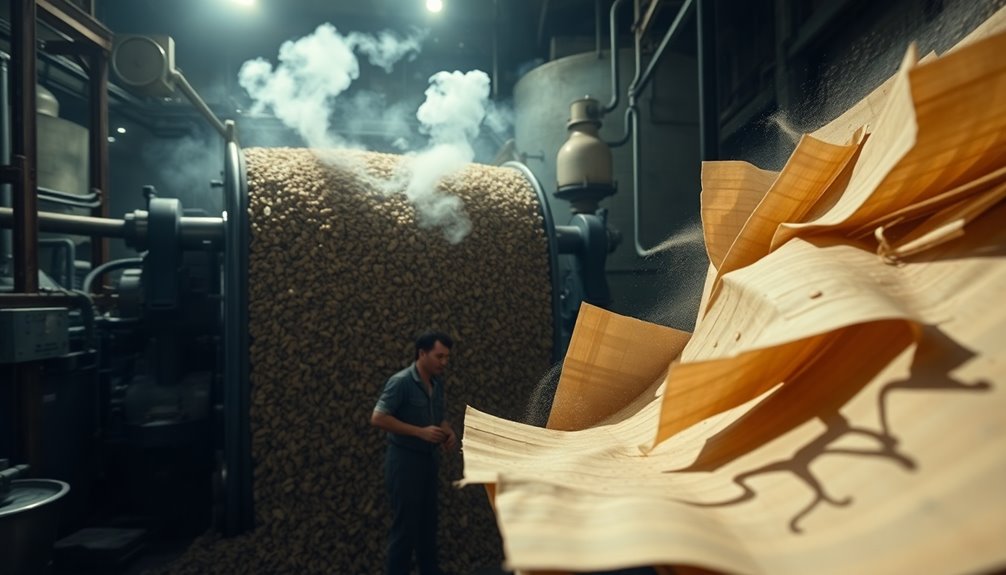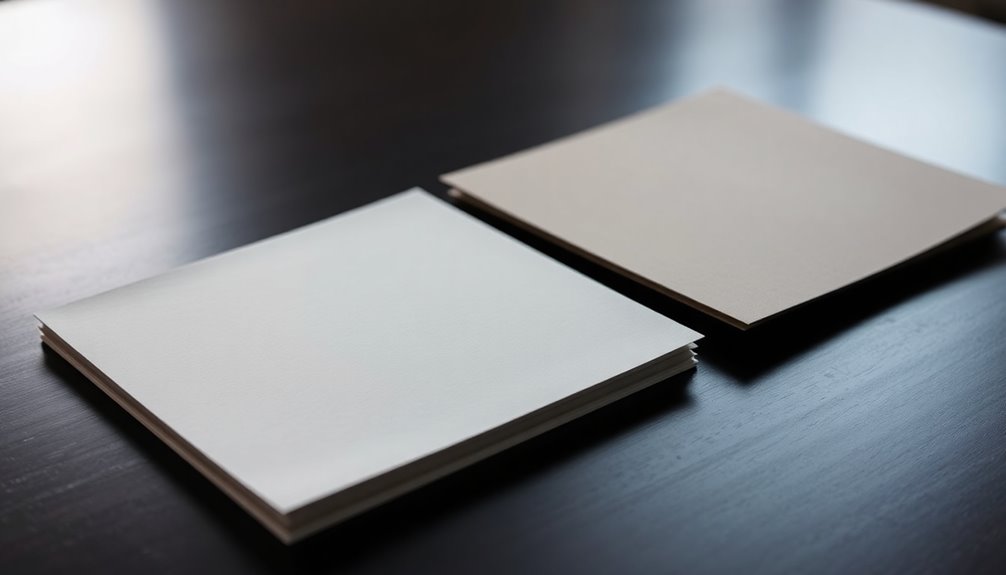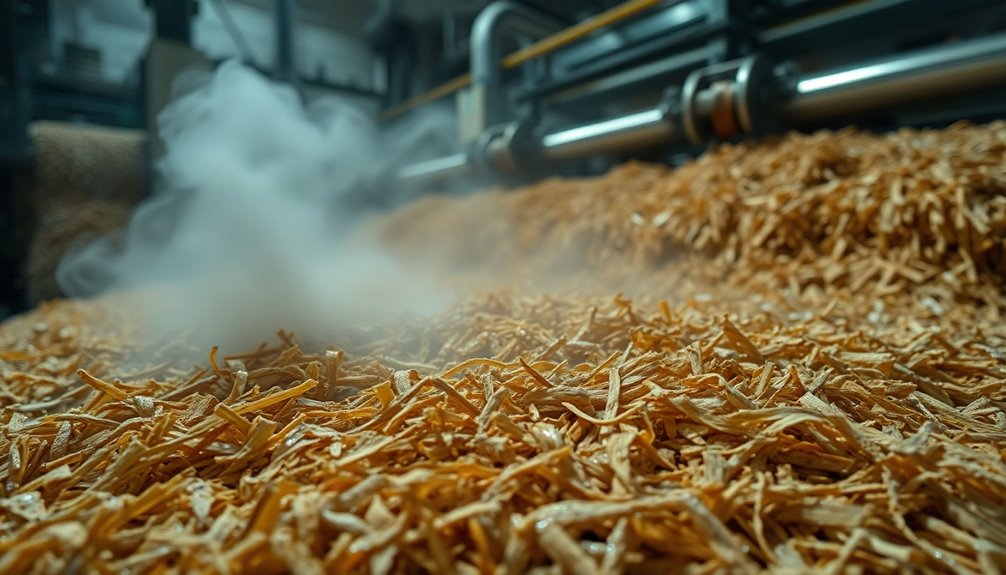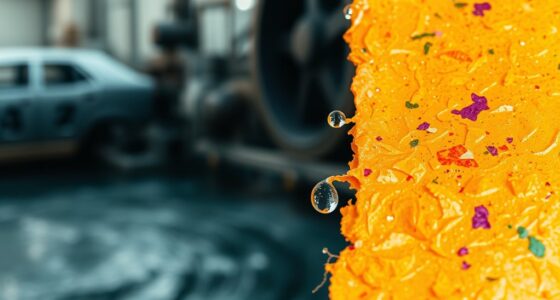Kraft paper's made through a process called the kraft method. You start with wood chips, which get cooked in chemical digesters using sodium hydroxide and sodium sulfide. This separates the cellulose fibers from lignin, creating a strong pulp. After washing and screening, the pulp is dried. You can choose between virgin kraft paper, known for its strength, or recycled kraft, which is more eco-friendly. The result is a durable, tear-resistant paper perfect for packaging and various uses. If you're curious about its properties and applications, there's plenty more to discover about this versatile material.
Key Takeaways
- Kraft paper is made using the kraft process, which chemically breaks down wood chips with sodium hydroxide and sodium sulfide to separate cellulose fibers from lignin.
- Wood chips are cooked in digesters, producing strong pulp with high tear resistance and tensile strength.
- The pulp undergoes washing and screening to remove impurities, and bleached kraft paper is further bleached before drying.
- The production process is flexible, allowing for the use of both virgin and recycled materials, contributing to sustainability.
- Approximately 90% of the pulping chemicals are recovered and reused, minimizing environmental impact during kraft paper production.
Overview of Kraft Paper

Understanding Kraft paper starts with recognizing its unique production process, known as the kraft process. This method involves breaking down wood chips using pulping chemicals, specifically sodium hydroxide and sodium sulfide, to separate cellulose fibers from lignin.
During the manufacturing process, wood chips are cooked in digesters under controlled temperatures and pressures, resulting in a strong pulp that's subsequently washed, screened, and dried.
Kraft paper stands out for its high tear resistance and tensile strength, making it an ideal choice for heavy-duty applications across various industries. You'll find that it's available in both unbleached and bleached types, catering to different aesthetic and functional needs. The unbleached version retains the natural color of the fibers, while the bleached type offers a cleaner, brighter appearance.
Additionally, the kraft process is designed with sustainability in mind. It allows for the recovery and reuse of approximately 90% of the pulping chemicals, promoting sustainable packaging solutions that minimize environmental impact.
Production Process

The production of kraft paper begins with the kraft process, where wood chips undergo a chemical transformation. In this method, wood chips are cooked with a hot alkaline chemical mixture, primarily sodium hydroxide and sodium sulfide. This cooking process breaks down lignin and separates cellulose fibers, resulting in a pulp that's rich in these essential components.
The process typically occurs in digesters under controlled temperatures and pressures, allowing about 90% of the pulping chemicals to be recovered and reused sustainably. After cooking, the pulp is washed and screened to remove impurities. If bleached kraft paper is desired, the pulp undergoes additional bleaching before it's dried into paper sheets.
One of the key advantages of the production process is its flexibility; it can incorporate both virgin and recycled materials, minimizing waste and optimizing energy use. This adaptability allows for the creation of kraft paper in various thicknesses and textures, making it suitable for a wide range of applications, from packaging materials to crafts.
Ultimately, the kraft process guarantees you get a durable and versatile product.
Types of Kraft Paper

When it comes to kraft paper, you'll find two main categories: virgin and recycled.
Virgin natural kraft paper offers unmatched strength for heavy-duty tasks, while recycled options are eco-friendly and perfect for reducing waste.
Additionally, specialty kraft papers like colored or bleached types serve specific needs, from crafting to retail packaging.
Virgin vs. Recycled Kraft
Exploring the differences between virgin and recycled kraft paper reveals key factors that influence their use in various applications.
Virgin kraft paper, produced from freshly harvested wood fibers, offers high strength and durability due to its long cellulose fibers and low lignin content. This type exhibits superior tear resistance and tensile strength, making it ideal for high-value packaging solutions.
On the other hand, recycled kraft paper is made from post-consumer waste paper, making it an eco-friendly option. It can contain up to 100% recycled content and requires fewer chemicals in the kraft process, using sodium hydroxide and sodium sulfide primarily for cleaning contaminants.
However, recycled kraft paper generally has lower durability due to shorter fiber lengths from the recycling process.
Both types offer customization options for various applications. You might find that virgin kraft paper is often preferred for applications requiring outstanding strength, while recycled kraft paper is a favored choice for sustainable packaging solutions.
Ultimately, your choice between virgin and recycled kraft paper will depend on your specific needs regarding strength, environmental impact, and application.
Specialty Kraft Paper Types
Diving into the world of specialty kraft paper types reveals a variety of options tailored for specific applications. One of the standout choices is sack kraft paper, known for its high elasticity and tear resistance, making it perfect for packaging materials like cement and food products. Often, it features a polyethylene coating to protect against moisture.
If you're looking for a more polished look, consider bleached kraft paper. This type undergoes chemical processing for a lighter color, but keep in mind it's generally weaker than unbleached kraft options.
For creative projects, colored kraft paper is a popular choice, often referred to as construction paper, available in various shades to inspire your artistic side.
Black kraft paper serves as an excellent backdrop for crafts, enhancing visual appeal in projects like photo frame backing.
Finally, clay coated kraft (CCK) improves opacity and printability, making it suitable for graphic arts and silicone-coated release liners, providing enhanced smoothness.
With these specialty kraft paper types, you can find the right fit for your specific needs.
Benefits of Kraft Paper
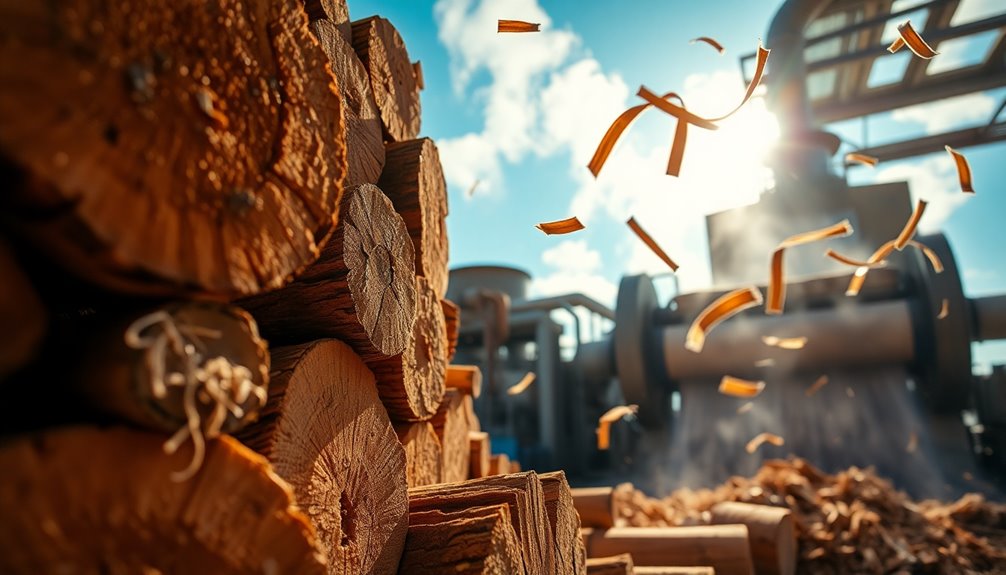
Kraft paper offers some impressive benefits that make it a smart choice for your packaging needs.
You'll appreciate its eco-friendly nature, as it's fully recyclable and biodegradable, helping reduce waste.
Plus, its lightweight and durable qualities not only cut shipping costs but also open up a world of versatile applications for your business.
Environmental Sustainability Advantages
In recent years, the demand for environmentally friendly packaging solutions has surged, and kraft paper stands out for its sustainability advantages. Its unique characteristics make it a go-to choice for businesses committed to eco-friendly practices.
Here's a quick look at the benefits of kraft paper:
| Advantage | Description | Impact |
|---|---|---|
| Recyclable | 100% recyclable, supporting waste reduction | Reduces landfill waste |
| Biodegradable | Breaks down naturally over time | Supports sustainability efforts |
| Resource Efficiency | Recovers 90% of pulping chemicals in production | Minimizes environmental impact |
| Circular Economy | Made from recycled and non-wood materials | Less reliance on virgin fibers |
| Lower Chemical Use | Uses fewer chemicals than plastic alternatives | Reduces overall environmental footprint |
Cost-effective Packaging Solution
As businesses increasingly prioritize sustainability, kraft paper not only meets eco-friendly standards but also serves as a cost-effective packaging solution. Its lightweight nature reduces shipping costs and overall material expenses, making it an ideal choice for budget-conscious companies.
Here are some key benefits of using kraft paper:
- Durable: With high tear resistance, kraft paper provides reliable heavy-duty packaging, minimizing the need for additional protective materials.
- Recyclable and Biodegradable: Kraft paper's eco-friendly nature allows for easy recycling and decomposition, appealing to environmentally conscious consumers.
- Lower Manufacturing Costs: The sustainable process used in kraft paper production allows for the recovery and reuse of about 90% of pulping chemicals, contributing to reduced manufacturing costs.
- Economies of Scale: Its versatility across industries enables bulk purchasing and manufacturing, leading to financial benefits for businesses.
Versatile Application Uses
Versatility is one of kraft paper's standout features, making it an essential material across various industries. You'll find kraft paper used in a wide range of applications due to its durability and high tear resistance.
It's particularly popular in heavy-duty packaging, ensuring your products, whether cement or food items, remain safe during transportation and storage.
Kraft paper is eco-friendly, being 100% recyclable and biodegradable, which aligns perfectly with the growing demand for sustainable practices in retail and e-commerce. You can confidently use it for packaging, knowing it supports your commitment to the environment.
Additionally, its food-safe properties make it ideal for food packaging, providing natural grease resistance while meeting health standards.
Beyond packaging, kraft paper shines in arts and crafts. Its rustic aesthetic and sturdy texture make it a favorite for scrapbooking, gift wrapping, and various creative projects.
It's also an excellent choice for protective padding, offering cushioning for fragile items while keeping shipping costs down with its lightweight profile.
With these versatile applications, kraft paper proves to be a multifunctional material that meets diverse needs effectively.
Applications in Packaging

Kraft paper's impressive strength and durability make it a top choice for various packaging applications.
This versatile kraft paper is ideal for a wide range of packaging products, from shipping corrugated boxes to food wrapping. Its natural grease resistance and food-safe properties guarantee compliance with health standards, making it perfect for food packaging.
Here are some key applications of kraft paper in packaging:
- Heavy-duty applications: Perfect for shipping and storing heavy items, providing the strength needed for protection.
- Food wrapping: Safely wraps food items while maintaining freshness and compliance with health regulations.
- Printed kraft paper: Customizable for branding and marketing, making it popular for promotional packaging.
- Protective padding: Acts as a biodegradable alternative to plastic fillers, reducing waste while protecting fragile items.
Environmental Impact

The growing importance of eco-friendly packaging options has spotlighted the environmental benefits of kraft paper. This material stands out due to its production process, which utilizes a nearly closed-loop cycle, recovering and reusing about 90% of the chemicals used in pulping. This greatly reduces waste and lowers the overall environmental impact compared to other paper manufacturing methods.
Kraft paper is 100% recyclable and can be recycled multiple times while maintaining quality, supporting a circular economy and minimizing the need for virgin materials. Its biodegradability guarantees that it breaks down naturally over time, which helps in reducing landfill waste and contributes to sustainable waste management strategies.
As consumer demand for eco-friendly packaging rises, innovations in kraft paper recycling and production are being prioritized. By choosing kraft paper, you're not only opting for a versatile packaging solution but also participating in a larger movement toward waste reduction and environmental responsibility.
With lower chemical usage, recyclability, and biodegradability, kraft paper is a clear choice for anyone looking to make a positive impact on the environment.
Frequently Asked Questions
What Is the Process of Making Kraft Paper?
To make kraft paper, you start by cooking wood chips in a mixture of sodium hydroxide and sodium sulfide. This breaks down the lignin and separates the cellulose fibers.
Once cooked, you wash and screen the slurry to remove impurities. The clean pulp is then pressed into sheets using rollers.
You can choose to bleach it or leave it unbleached, depending on the final product you want. The process emphasizes sustainability by reusing most chemicals.
What Is the Raw Material for Kraft Paper?
When you think about kraft paper, the raw materials that come to mind are wood chips, primarily from softwood trees like pine and spruce.
These woods provide the long fibers needed for strength. You might also consider hardwood pulp for added flexibility, along with non-wood agricultural residues and recycled paper for sustainability.
This combination not only enhances the paper's quality but also supports eco-friendly practices in the industry.
Is Kraft Paper 100% Recycled?
Kraft paper isn't always 100% recycled. While some types are made entirely from recycled materials, others use a mix of recycled and virgin fibers to enhance strength and durability.
You'll find that recycled kraft paper is more eco-friendly but generally less sturdy due to fiber degradation.
Keep in mind that even recycled kraft can only be processed about seven times before the fibers become too short for further use.
What Is the Difference Between Kraft Paper and Regular Paper?
Kraft paper and regular paper differ mainly in their strength and production methods.
You'll find kraft paper's thicker, more durable, making it perfect for heavy-duty applications. Regular paper often gets bleached for a white finish, which can weaken it.
Plus, kraft paper is fully recyclable and biodegradable, while regular paper mightn't be, depending on coatings.
Conclusion
To sum up, kraft paper's unique production process and versatility make it a popular choice for various applications. Its strength and durability benefit both businesses and consumers alike, while its environmentally friendly qualities resonate with those seeking sustainable options. Whether you're using it for packaging, crafts, or other projects, kraft paper proves to be a reliable material. By choosing kraft paper, you're not just making a practical choice; you're also supporting eco-conscious practices that help protect our planet.



